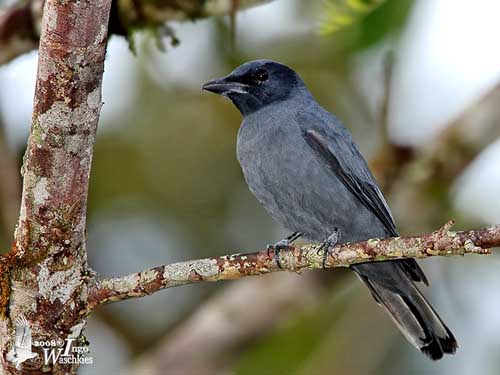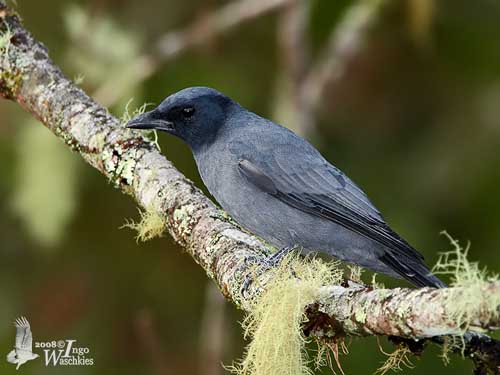
Fr: Echenilleur de la Sonde
All : Larvenraupenfänger
Esp: Oruguero de Cara Oscura
Ital: Coracina larvata
Nd: Zwartmaskerrupsvogel
Sd: Sundagråfågel
Photographer:
Ingo Waschkies
Bird Photography
Text by Nicole Bouglouan
Sources:
HANDBOOK OF THE BIRDS OF THE WORLD Vol 10 by Josep del Hoyo-Andrew Elliott-David Christie - Lynx Edicions - ISBN: 8487334725
L’ENCYCLOPEDIE MONDIALE DES OISEAUX - Dr Christopher M. Perrins - BORDAS - ISBN: 2040185607
BirdLife International (BirdLife International)
Wikipedia, the free encyclopaedia
Sunda Cuckooshrike
Coracina larvata
Passeriformes Order – Campephagidae Family
BIOMETRICS:
Length: 26-27 cm
DESCRIPTION:
The cuckooshrikes of genus Coracina are relatively large with broad bill, and they are usually sexually monomorphic. This genus includes the largest members of the Campephagidae family.
The adult male of the nominate race has dark slaty grey plumage, including the upperwing-coverts. The alula is black. The black primary coverts and the primaries are edged slaty grey. The secondaries are similar but the grey edges are broader. The tertials are slaty grey on outer webs, and black on inner webs. The tail is black with pale grey-tipped rectrices.
The underparts are slaty grey too, with dark grey chin, throat and thighs. Underwing-coverts and axillaries are slaty grey.
On the head, the crown is slaty grey. Head sides are paler, but lower forehead and lores are dusky, whereas ear-coverts and the area around the eye are slaty black.
The broad bill is black. The eyes are dark brown. Legs and feet are black.

The female is very similar but she has smaller black mask. Underwing-coverts are barred grey and white. There is sometimes some barring on the undertail-coverts.
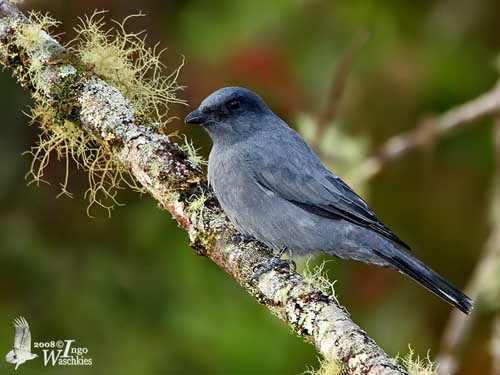
The juvenile resembles female with whitish feather edges.
The immature is similar to female with more pronounced barring on underwing-coverts.
There are three subspecies:
C.l. larvata (here described and displayed) is found in Java.
C.l. melanocephala occurs in Sumatra. This one has entirely black head.
C.l. normani is found in Borneo. This race has intermediate extend of black on head.
VOICE: SOUNDS BY XENO-CANTO
The Sunda Cuckooshrike gives harsh, ringing whistles “eeooo-eeooo-eeooo” or “shreeok”. It also utters a loud, wheezy song.
HABITAT:
The Sunda Cuckooshrike frequents humid forest, both pine forest with Pinus and mossy forest. This species is visible in highlands, between 850 and 2200 metres of elevation.
RANGE:
See above in “subspecies”
BEHAVIOUR:
The Sunda Cuckooshrike feeds primarily on several large insect species and spiders, and also takes some fruits and berries.
It can be seen foraging singly or in pairs, often in treetops. It is mainly arboreal forager, moving slowly and methodically. It hops or walks along branches while gleaning arthropods. It hops or flies from branch to branch and from tree to tree.
However, it may come to the ground in the early morning for feeding, and it sometimes joins mixed-species foraging flocks.
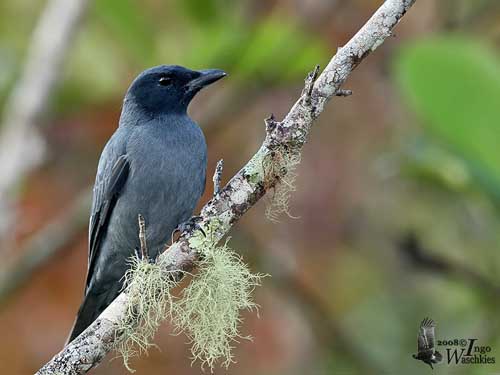
The Sunda Cuckooshrike often stays in the upper canopy, perching motionless on a branch and sometimes for long period, making the bird very difficult to find.
When alighting, it may sometimes flick the wings, including when perched.
They are territorial during the breeding season. During displays, the feathers of lower back and rump are puffed-up over the back during courtship or defence displays, or when the bird is alarmed. When disturbed, it raises these feathers and directs its back towards the danger. These stiffened and enlarged feathers are spine-like and may deter a small predator.
This species is monogamous with pair-bonds maintained throughout the year. There is no information about the breeding behaviour of this species, but several large cuckooshrikes perform displays in which the male lifts each wing alternately and repeatedly while calling strongly. Chases accompanied by screaming calls may also occur.
The Sunda Cuckooshrike is probably resident in its range, with any recorded movement.
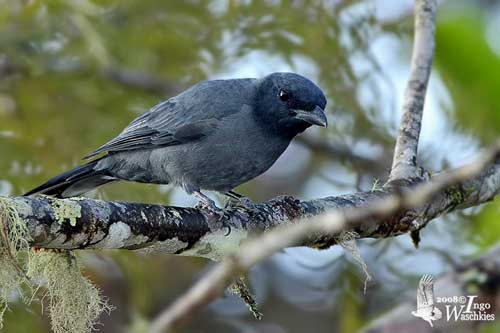
FLIGHT:
The Sunda Cuckooshrike has an undulating, cuckoo-like flight, alternating flapping to gain height with gliding on downwards held wings.
REPRODUCTION:
There is no available information about the reproduction of this species, but there are some generalities about the large cuckooshrikes of this family.
They nest in tall trees, often high above the ground, and near the end of the branch, not among the foliage.
The nest is cup-shaped, made with twigs, roots, bark, grasses, lichens, moss, plant down, wool and horsehair. The inner cup may be lined with soft materials, but sometimes it may be left unlined. Both sexes build the nest.
Several species in the genus Coracina regularly lay a single egg. The female usually incubates alone during 21-27 days, but she is fed by the male which also defends the nest area. Then, both adults share the nesting duties.
The chicks are altricial and nidicolous. The fledging period may last 20-30 days. The juveniles remain with parents for some weeks after fledging.
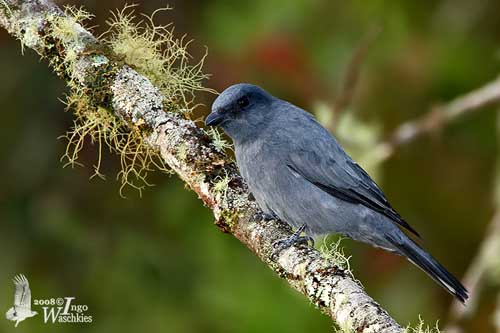
DIET:
The Sunda Cuckooshrike feeds mainly on large insects such as lepidopteran larvae, Coleoptera (beetles), grasshoppers, crickets and ants. It also takes spiders and consumes fruits, mainly figs, and berries from several plant species.
PROTECTION / THREATS / STATUS:
The Sunda Cuckooshrike is not currently threatened. Its populations appear fairly stable in spite of continuing small declines. This species is fairly common to locally common according to the region.
